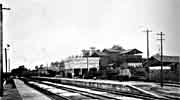| Fukuoka POW Camp
#26-B Keisen (Yoshikuma) |
Camp List Home
| Fukuoka 26-B Keisen (ASO KOGYO YOSHIKUMA TANKO) Yoshikuma Coal Company, Aso Mining Co. FUKUOKA-ken, KAHO-gun, KEISEN-machi Satellite map - Camp sits on a rise surrounded by a 10 ft fence. Six barracks, slate rooks, each with five 12 mat rooms with hallway running length of each building (sliding door access). Note there is a large golf course (Aso-Iizuka Club) adjacent to the old site. Aerial (Nov. 1947; courtesy of Japan Map Archives) Area map Time Line: 10 May 1945: Camp established as Fukuoka Branch #26; 1 British and 199 Australian POWs arrive from Tokyo POW camp in Maruyama, Kawasaki 21 Jun 1945: 100 British POWs from Fukuoka #2 Nagasaki and 2 Dutch POWs from Fukuoka #14 Nagasaki arrive Sept 1945: Rescue effected POWS arrived at the Usui railroad station, just south of the camp. Photographs:  Overall view of camp (how it looks today)  Train loading station  Group photograph of Australians (VJ Day) Group picture of Aussies approx. six weeks after surrender. Most still appear emaciated. Caption indicates "Usui" which was the nearby railroad station. From Ken Gregson: "My late father, Robert George Gregson, (known as George), is the chap seated on the very left." Group portrait of Allied POW doctors and senior officers (Aug. 18, 1945) "Group portrait of Allied
prisoner of war (POW) doctors and senior officers, believed to be in
Fukuoka Camp No 7B [NOTE: Should be Camp #26],
with the Japanese camp commander and guards. Identified, left to right,
front row: unidentified RAF doctor; unidentified Dutch doctor; Flight
Lieutenant R R McSwiney, RAF doctor; Japanese camp commander with
ceremonial family sword (probably Tsuyoshi Sakai); Squadron Leader
(later Air Commodore) McCarthy, RAF; Dutch doctor Lieutenant 1 Alidus
Theodorus Groot Wesseldijk; unidentified British Warrant Officers.
Second row: unidentified Japanese guard; two unidentified British Chief
Petty Officers; two unidentified Japanese guards. Back row: six
unidentified Japanese guards. Note that a number of the POWs are
wearing rank insignia, which they were previously forbidden to wear."
MacCarthy Collection (Courtesy of the MacCarthy family, Castletownbere, Ireland, with special thanks to Bob Jackson for scans; for further details, see A Doctor's Sword, including a documentary.) FUK-26 MacCarthy collection Group photo of British POW's
Message from the Commander of Fukuoka Prisoners of War Camps, Aug. 22, 1945 No. 26 Camp Orders by Sqdn Leader J.A. MacCarthy, Sept. 3, 1945 Supply drop notice to POW's Note from "Lucky 13" (see below transcript) Statement from the Chinese Camp: Why we killed the Chinese officer in command of our camp "This is the text from a hand-written note which was included with the supplies dropped by the US Air Force following the Japanese surrender. It is from the crew of the "Lucky 13." The USAF 13th Squadron was involved dropping supplies on camps in mainland Japan following the Japanese surrender." --Bob Jackson Hi ya fellas,
Here’s some good old army chow, don’t know when we’ll be back again. Hope you enjoy all the drops and hope there’s plenty for all. How’s our aim anyway? We hope its better than usual. Our crew "The Lucky 13" wish you all a very speedy trip home which we know you’re all waiting eagerly for, but believe me everything possible is being done to get you boys back home as swiftly as possible. The sooner MacArthur steps on Japanese soil the quicker you’ll leave. Well I hope you find this letter is all I can say, that’ll depend on our aim. Well I’ll close now so the crew of the Lucky 13 say so long and may God be with you and Bless you all. Lucky 13 NOTICE |
Slave
Labor: POWS used in coal mining in formerly closed and dangerous mine. This mine system was - and still is - owned by the Aso family. The son, Taro Aso, was the Prime Minister of Japan in 2009 (see here for details). The Aso family continues to deny it used any slave labor during the war. In early January 2009, Prime Minister Aso admitted the mining company used prisoners but denied any responsibility for any abuse or deaths. He issued a meaningless apology. News Story: From the Japan Times - proof of slave labor being used at Aso Mines (see also here). In post-war report, Aso Mining denied responsibility for the two deaths even though they happened over two months after arrival. Both died from effects of severe malnutrition. Underwood article in the Asia-Pacific Journal, and this article; Shukan Gendai article with English translation. Japanese Report Blueprints Camp Report Mgmnt Mining Co. - asst. reports on camp #26, table on management of all Kyushu camps, Yoshikuma Mining Co. (Aso Mining) report Hell Ships: First group arrived on the Asama Maru. Many men transferred here from Fukuoka #2 Nagasaki. A large number of the men British definitely came up on the WALES MARU (Weills) which departed Singapore 16 May 1943. (per diary of Wilkie and contacts from John H. Byrnes- Source: Robin Lim). A number of these men were transferred here from Kobe House (camp 2B). Known that most of the Aussies came up on the Awa Maru. Rosters: Total = 300 POWs (197 Australian, 101 British, 2 Dutch; 2 deaths) Australians: 197 men with rank and units (Includes two who died; Watson and Wilkie). Australian roster prepared by Neil MacPherson and Morris Casey of Australia (revised per actual rescue rosters, RG 331 Box 927). British: 100 men including one officer; rosters located RG 331 Box 927 Dutch: Two men: Belmorte, Colaco Arnold Herman Maximiliaan, NEI Army, Kapitein Doktor, POW# 15301 Groot Wesseldijk, Alidus Theodorus, NEI Army, Luitenant Doktor, POW# 15302 Original rosters List 1 Original rosters List 2 FUK-26 Rosters 1946-02-16 Affidavits: Jorgenson, William Victor- short affidavit Hill, Athol George - short affidavit Watson affidavit Maruta testimony Books: "George Smith McNab" - based upon camp note book & diary. Written by his grandson, Brian Coutts. |